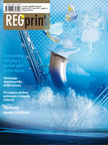«
Back to content
Vol 3 | Year 2012

Manfred Werfel, Interim CEO, Executive Director Competence Centre Newspaper Production
Newspapers Are Not Old News
Manfred Werfel, Interim CEO and Executive Director Competence Centre Newspaper Production of WAN-IFRA, talks about some of the most important trends related to printed media in times of general digitalisation, as well as times when newspaper companies have to increase their struggle for maintaining their readers and circulation numbers. In the next few years, both local and global printing and newspaper companies will have to integrate inevitable innovations, because of the fact that readers st
In the next few years, both local and global printing and newspaper companies will have to integrate inevitable innovations, not only because of the growing “danger” seen in the aspect of digital media, but also because of the fact that readers still spend more time interacting with the printed and not so much with the digital media, which means that the necessary innovations and the acceptance of new technologies will bring new opportunities for keeping the old and attracting new readers, giving a new, positive sweep even to the close related printing industry.
In the last few years we are witnessing significant changes, which at first glance, show that printed media are being pushed out by the electronic ones. As a sort of an introduction to our interview, do you think you could break down this prejudice for us and defend the role of printed media or are things definitely different in reality?
According to the data of the latest edition of our World Press Trends, more than half the world’s adult population read newspapers: more than 2.5 billion in print and more than 600 million in digital form. That represents more readers and users than global users of Internet in total.
The 2012 World Press Trends update found the following: in 2011, newspaper paid-for circulation increased by 1.1% globally compared with 2010, reaching the amount of 512 million. The global newspaper audience has grown by 4.2% since 2007. More than 40% of the world’s digital audience read newspapers online, which represents an increase from the 34% of online readers from a year ago. Free newspapers continue to be a factor in many markets, despite some retrenchment, and saw global distribution of 36 million in 2011. Asia now accounts for a third of global circulation and has seen circulations grow by 16% over five years, while those in Western Europe and North America have declined by 17% during the same period.
Newspapers are strong worldwide in print and they are growing in digital and mobile channels. From the perspective of the newspaper industry the challenge is finding successful business models for the digital age.
The global economic crisis has left trace on all industrial fields, as well as on the newspaper industry, which had its ups and downs during the recent period. What is the current situation?
Advertising revenue is declining during the economic crisis. Typically it will pick up with a certain delay when the economic situation improves. The deep European debt crisis is an additional factor that limits investments and expenditure.
On global perspective, we see a diverse situation of the newspaper publishing industries. In the USA, one of the largest newspaper markets, the depression was very deep and caused many serious situations for publishing houses who were forced to implement drastic cuttings. Some reduced their publication days and some even had to close. In the present moment, we see the first signs of a possible recovery starting in the USA.
In Canada we have seen how large publishing houses successfully opposed the negative market trends with new business models, including product upgrades rather than responding with only cost cutting.
The European industry was better prepared for the economic decline. The copy sales revenue surpasses the advertising revenue in recent years, as investments never came to a halt in the European newspaper industry. Newsrooms were streamlined for the multimedia future and production equipment was updated and automated to allow lower cost per copy.
In most of Asia the general growth development continued to dominate the markets. Newspapers in India, Indonesia and China are still growing in circulation and in page count. Production quality has improved impressively and still is improving. All these factors show that the global publishing market delivers a diverse picture. The sun rises in the East and it sets in the West. So does the newspaper industry grow in the East and stagnate in the West.
In one of the researches which Microsoft conducted for its own needs, the final results showed that each pound invested into newspaper advertising brings five pounds of revenue, in comparison with advertising campaigns aired as parts of TV programmes which bring a 2.2 pound revenue, and with the online equivalent which brings a 3.4 pounds revenue. How would you comment on this data from the present position?
It is very unfortunate that some advertising agencies and ad brokers do not pay enough attention to the importance of the media mix. Newspaper advertising does not only deliver the best ratio of cost and result, but we also know from many research projects that newspaper advertising works especially well in supporting the customers’ purchasing decisions. For image promotion of a company or a product, other advertising channels are also powerful but for making the final buying decision, customers rely very strongly on newspaper advertising. That’s why weekend editions are so successful.
The recently held World Newspaper Congress in Kiev presented the most actual trends and directions in which this industry will be developing in the few next years. Can you give us a brief presentation of the Congress’ light motifs?
The President of WAN-IFRA said during the opening ceremony of the Congress: “We have gathered in this city to discuss and debate global as well as local events, and to show our solidarity with the entire media fraternity.”
These important topics and themes were presented and discussed during the recent World Newspaper Congress in Kiev:
• The importance of press freedom for the development of democracy and social life. What are the business opportunities during economic depression?
• What are successful advertising strategies?
• The pros and cons of paywalls for the generation of more paid content.
• How can local and hyperlocal concepts contribute to the success of newspapers?
• How to reorganise the newsroom for the future?
• What is the role of social media for newspapers?
• What is the best relationship between digital and print?
• How to engage more young readers?
• The situation of the publishing industry in Eastern Europe.
The digital evolution is something that is unquestionably present. What are the ways to keep up the competitiveness for the printed media, specially for newspapers?
Each newspaper company should find out what is the strength of print in comparison with other publishing channels and platforms. Then you should use and explore the specific strengths of print for your specific business situation. In other words: let print do what print can do best, and let online and digital mobile do what they can do best. Finally: cross-link the different media platforms.
When you analyse it you will find out that print – despite other media – can address all five human senses: sight, smell, hear, taste and feel. We know that all senses are relevant between 25% and 58% for the buying decision of customers. Print ads can address all senses with the help of colour (sight), scented inks (smell), “speaking ads” (hear), even “edible ads” (taste) and special paper qualities (feel). Print can create a holistic experience for the reader and user.
Also, print can build bridges to other media with the help of Quick Response Codes, “clickable paper”, augmented reality, electronic promotion cards, video in print or “touchcode” technology. There is a growing number of developing technologies which provides links from print into digital and mostly digital mobile media. All of this demonstrates that print is a vivid medium and not “dead wood”.
In your opinion, taking in consideration the present knowledge and comprehension, what will future newspapers look like?
Future newspapers will look more like magazines. Some people started using the term “daily magazine” already. News are still important, but stories are gaining importance. Speed of news publishing is less important since other media will always be faster, but depth of reporting and of story telling is gaining importance. Readers expect value added information and background, not just the naked news. It is common sense that commodity news will be very hard to sell in future. So, every newspaper has to find their niche.
Let’s put aside the relation between printed and electronic media for a moment, and take in consideration a new trend that is raising new challenges for printers. Green publishing and the reduction of carbon footprint will soon be regulated by ISO standard – ISO 16759. Which are the advantages that will come out of this, in terms of sustainability?
Green publishing will not only be a challenge but also a great chance for publishers and newspaper printers. Why? First of all, because it forces them to look into their processes and eliminate the energy eating leaks and procedures. This is positive because it will be good for the environment, but also for the cost situation. Energy is one of the most expensive factors in production and the price for energy will not decrease in future. Second, you can offer green products to your customers. This is a new benefit newspapers did not offer in the past. In the future they will be able to offer a full-page, full-colour ad that is fully carbon neutral. This will be of interest for some advertisers who want to prove their sustainability in advertising their biological or eco-friendly products. We like to say: go green and grow green. It is a challenge, but is is a growth opportunity as well.
You are specialized in reproduction and prepress applications as well as in colour management and printing standardisation in newspaper environments. Which are the main challenges in these fields and which are the “weak links” that require additional work efforts?
Since the first coldset offset printing standard has been released in 1998, the print standardisation has made incredible progress. Newspaper printers all over the world know about the specifications of the standard and how they can make sure the standard is observed in daily production. The biannual colour print competition for membership in the International Newspaper Color Quality Club demonstrates this progress impressively.
A growing challenge for print quality standardisation lies in the fact that more and more unskilled and untrained people deliver digital colour content for publication. Photos of local events are often taken with low-end cameras because it seems so easy to take a photo. But can it be reproduced and printed well?
You collaborated repeatedly with the Croatian graphic industry and we believe this gave you an insight to its functioning ways. What is your opinion about its current position and what message would you like to send out to our readers?
I have always been impressed by the high skill levels of Croatian graphic arts specialists in publishing and printing houses as well as in graphic institutes and universities. As a member of the International Association of Research Organizations for the Information, Media and Graphic Arts Industries (IARIGAI), I had the opportunity to listen to a number of scientific paper presentations of Croatian professors and students. Zagreb was and still is, in my opinion, the hub of graphic arts research and training in Southeast Europe. I wish that the Croatian graphic arts experts involve themselves even deeper into the international exchange using international organisations like WAN-IFRA, IARIGAI and others. I am convinced that this would be of mutual benefit for the global publishing and printing community.
In the last few years we are witnessing significant changes, which at first glance, show that printed media are being pushed out by the electronic ones. As a sort of an introduction to our interview, do you think you could break down this prejudice for us and defend the role of printed media or are things definitely different in reality?
According to the data of the latest edition of our World Press Trends, more than half the world’s adult population read newspapers: more than 2.5 billion in print and more than 600 million in digital form. That represents more readers and users than global users of Internet in total.
The 2012 World Press Trends update found the following: in 2011, newspaper paid-for circulation increased by 1.1% globally compared with 2010, reaching the amount of 512 million. The global newspaper audience has grown by 4.2% since 2007. More than 40% of the world’s digital audience read newspapers online, which represents an increase from the 34% of online readers from a year ago. Free newspapers continue to be a factor in many markets, despite some retrenchment, and saw global distribution of 36 million in 2011. Asia now accounts for a third of global circulation and has seen circulations grow by 16% over five years, while those in Western Europe and North America have declined by 17% during the same period.
Newspapers are strong worldwide in print and they are growing in digital and mobile channels. From the perspective of the newspaper industry the challenge is finding successful business models for the digital age.
The global economic crisis has left trace on all industrial fields, as well as on the newspaper industry, which had its ups and downs during the recent period. What is the current situation?
Advertising revenue is declining during the economic crisis. Typically it will pick up with a certain delay when the economic situation improves. The deep European debt crisis is an additional factor that limits investments and expenditure.
On global perspective, we see a diverse situation of the newspaper publishing industries. In the USA, one of the largest newspaper markets, the depression was very deep and caused many serious situations for publishing houses who were forced to implement drastic cuttings. Some reduced their publication days and some even had to close. In the present moment, we see the first signs of a possible recovery starting in the USA.
In Canada we have seen how large publishing houses successfully opposed the negative market trends with new business models, including product upgrades rather than responding with only cost cutting.
The European industry was better prepared for the economic decline. The copy sales revenue surpasses the advertising revenue in recent years, as investments never came to a halt in the European newspaper industry. Newsrooms were streamlined for the multimedia future and production equipment was updated and automated to allow lower cost per copy.
In most of Asia the general growth development continued to dominate the markets. Newspapers in India, Indonesia and China are still growing in circulation and in page count. Production quality has improved impressively and still is improving. All these factors show that the global publishing market delivers a diverse picture. The sun rises in the East and it sets in the West. So does the newspaper industry grow in the East and stagnate in the West.
In one of the researches which Microsoft conducted for its own needs, the final results showed that each pound invested into newspaper advertising brings five pounds of revenue, in comparison with advertising campaigns aired as parts of TV programmes which bring a 2.2 pound revenue, and with the online equivalent which brings a 3.4 pounds revenue. How would you comment on this data from the present position?
It is very unfortunate that some advertising agencies and ad brokers do not pay enough attention to the importance of the media mix. Newspaper advertising does not only deliver the best ratio of cost and result, but we also know from many research projects that newspaper advertising works especially well in supporting the customers’ purchasing decisions. For image promotion of a company or a product, other advertising channels are also powerful but for making the final buying decision, customers rely very strongly on newspaper advertising. That’s why weekend editions are so successful.
The recently held World Newspaper Congress in Kiev presented the most actual trends and directions in which this industry will be developing in the few next years. Can you give us a brief presentation of the Congress’ light motifs?
The President of WAN-IFRA said during the opening ceremony of the Congress: “We have gathered in this city to discuss and debate global as well as local events, and to show our solidarity with the entire media fraternity.”
These important topics and themes were presented and discussed during the recent World Newspaper Congress in Kiev:
• The importance of press freedom for the development of democracy and social life. What are the business opportunities during economic depression?
• What are successful advertising strategies?
• The pros and cons of paywalls for the generation of more paid content.
• How can local and hyperlocal concepts contribute to the success of newspapers?
• How to reorganise the newsroom for the future?
• What is the role of social media for newspapers?
• What is the best relationship between digital and print?
• How to engage more young readers?
• The situation of the publishing industry in Eastern Europe.
The digital evolution is something that is unquestionably present. What are the ways to keep up the competitiveness for the printed media, specially for newspapers?
Each newspaper company should find out what is the strength of print in comparison with other publishing channels and platforms. Then you should use and explore the specific strengths of print for your specific business situation. In other words: let print do what print can do best, and let online and digital mobile do what they can do best. Finally: cross-link the different media platforms.
When you analyse it you will find out that print – despite other media – can address all five human senses: sight, smell, hear, taste and feel. We know that all senses are relevant between 25% and 58% for the buying decision of customers. Print ads can address all senses with the help of colour (sight), scented inks (smell), “speaking ads” (hear), even “edible ads” (taste) and special paper qualities (feel). Print can create a holistic experience for the reader and user.
Also, print can build bridges to other media with the help of Quick Response Codes, “clickable paper”, augmented reality, electronic promotion cards, video in print or “touchcode” technology. There is a growing number of developing technologies which provides links from print into digital and mostly digital mobile media. All of this demonstrates that print is a vivid medium and not “dead wood”.
In your opinion, taking in consideration the present knowledge and comprehension, what will future newspapers look like?
Future newspapers will look more like magazines. Some people started using the term “daily magazine” already. News are still important, but stories are gaining importance. Speed of news publishing is less important since other media will always be faster, but depth of reporting and of story telling is gaining importance. Readers expect value added information and background, not just the naked news. It is common sense that commodity news will be very hard to sell in future. So, every newspaper has to find their niche.
Let’s put aside the relation between printed and electronic media for a moment, and take in consideration a new trend that is raising new challenges for printers. Green publishing and the reduction of carbon footprint will soon be regulated by ISO standard – ISO 16759. Which are the advantages that will come out of this, in terms of sustainability?
Green publishing will not only be a challenge but also a great chance for publishers and newspaper printers. Why? First of all, because it forces them to look into their processes and eliminate the energy eating leaks and procedures. This is positive because it will be good for the environment, but also for the cost situation. Energy is one of the most expensive factors in production and the price for energy will not decrease in future. Second, you can offer green products to your customers. This is a new benefit newspapers did not offer in the past. In the future they will be able to offer a full-page, full-colour ad that is fully carbon neutral. This will be of interest for some advertisers who want to prove their sustainability in advertising their biological or eco-friendly products. We like to say: go green and grow green. It is a challenge, but is is a growth opportunity as well.
You are specialized in reproduction and prepress applications as well as in colour management and printing standardisation in newspaper environments. Which are the main challenges in these fields and which are the “weak links” that require additional work efforts?
Since the first coldset offset printing standard has been released in 1998, the print standardisation has made incredible progress. Newspaper printers all over the world know about the specifications of the standard and how they can make sure the standard is observed in daily production. The biannual colour print competition for membership in the International Newspaper Color Quality Club demonstrates this progress impressively.
A growing challenge for print quality standardisation lies in the fact that more and more unskilled and untrained people deliver digital colour content for publication. Photos of local events are often taken with low-end cameras because it seems so easy to take a photo. But can it be reproduced and printed well?
You collaborated repeatedly with the Croatian graphic industry and we believe this gave you an insight to its functioning ways. What is your opinion about its current position and what message would you like to send out to our readers?
I have always been impressed by the high skill levels of Croatian graphic arts specialists in publishing and printing houses as well as in graphic institutes and universities. As a member of the International Association of Research Organizations for the Information, Media and Graphic Arts Industries (IARIGAI), I had the opportunity to listen to a number of scientific paper presentations of Croatian professors and students. Zagreb was and still is, in my opinion, the hub of graphic arts research and training in Southeast Europe. I wish that the Croatian graphic arts experts involve themselves even deeper into the international exchange using international organisations like WAN-IFRA, IARIGAI and others. I am convinced that this would be of mutual benefit for the global publishing and printing community.
















